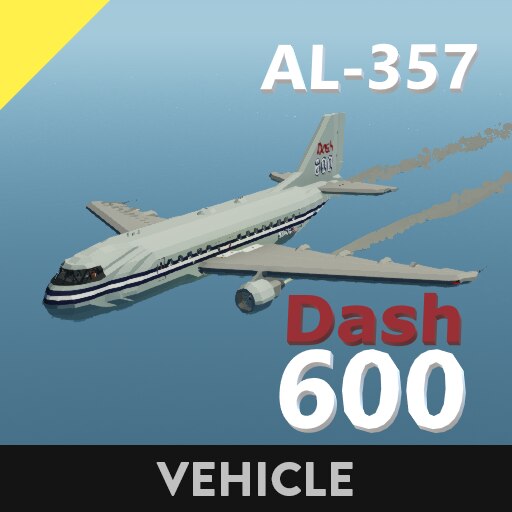ASOL AL-357 "Dash 600"
(Updated 05/03/2020) Fixed issue with nose pitching upward
(Updated 07/07/2020) Fixed missing electric logic
(Fictional) The ASOL AL-357-600 or more commonly known as is marketing name of "Dash 600" is a medium to long range twin engine passenger plane designed by ASOL Aviation to meet an increased demand in fuel efficient, medium sized twin engine jets. The Dash 600 was the 6th variant of the AL-357 model and unlike previous models has only 2 engines instead of 3 or 4. The Dash 600 is able to land at nearly any airport found in the world of Stormworks and in the event basic airport equipment is not available, an Air Stair located at the back provides easy access from the cabin to the ground.
The Dash 600 has a cruising Speed of 200 knots, over 41,000 liters of fuel in 2 fuel tanks, completely sealed cabin and cockpit with 8 auto sealing door, seating for 2 pilots, 1 relief pilot, 4 crew and 86 passengers, one galley at the front of the plane along with 2 lavatories, 2 cargo hatches on the starboard side and 2 sets of arctic gear and 4 parachutes.
Features:
The most prominent feature of the Dash 600 is it’s Air Stair located at the rear of the plane. Equipped with a set of toggleable Mag-Alls at the base of the stairs, this prevents any unwanted rolling or movement of the aircraft while it is on the ground.
The Dash 600 also includes powered landing gear wheels, allowing the plane to taxi on the ground without the use of its main engines. This feature allows the plane to move both forward and reverse at around 10 knots (This requires the APU to be turned on in order to work).
Cockpit:
– X/Y Autopilot
– Altitude hold
– Bearing hold
– Air speed hold (This is a work in progress and may not function as intended)
– Switch control to Co-Pilot
– Aircraft Stabilizer
– Disable All Warnings
– Landing gear lever
– Individual screens for both Pilot and Co-Pilot
– Individual screen cycle, and map zoom controls
– Artificial horizon, Variable zoom Map and Radar
– Warning Indicators for Over speed, Stall, Roll, Pitch, and Retract landing gear
– Engine throttle lever
– Speed brakes throttle lever
– VHF Marine Radio
– Cabin Speaker
Overhead:
– Taxi Lights
– Landing Lights
– Alternating Landing Lights
– Wing Inspection Lights
– Position Lights
– Anti-Collision Lights (Wings)
– Anti Collision Lights (Fuselage)
– Logo Lights
– Fuel gauges with low fuel warnings and fuel dump
– Cabin Lights, Seat belts, and Exit Lights
– Cockpit and Cabin Heaters
– APU Power Controls and Ground power lever
– Engine Power Controls
– Cockpit light cycle: Red, Green, White
– Clock
Engineers Panel
– Breakers for various aircraft systems
– Cockpit Door Lock
– Door open/close indicators
– The rest is decorative ans serves no other purpose
Start Up Procedure:
– Enter the cockpit and throw the 4 breakers at the top of the engine’s panel
– To start moving, make sure the Air Stair is retracted or the Mag-All’s are off, you can either use the Powered Landing Gear to move around on the ground (both forward and reverse) by turning on the APU or using the main engines to move.
– To start the main engines you will need to look to the center of the overhead, flip the Engine Cut-off Switches and then the Engine Ignitions, the engines will auto start and maintain a set rps (you do not need to touch the throttle lever until you are ready to take off)
Take Off:
– Prior to take off I’d recommend setting all cockpit systems in advance; Altitude, Bearing, Auto Pilot, ect. you can even use these to help take off and land
– When you are ready for take off or are in the air I recommend shutting of the APU if you have this on. In the air, this provides nothing more than a battery charge which is already provided from the main engines
– If you haven’t already, activate the altitude hold once you are in the air as the plane tends to pitch up at or near full throttle
–
Landing:
– I do not recommend using the Air speed Hold for landing
– I recommend leaving the Aircraft Stabilizer off and putting the Bearing Hold on the angle of the runway you are approaching, this allows some control in the direction you are heading but keeps you on course for the most part
– Line up the aircraft with the runway in advance
– Setting the throttle to 0.10
– When landing set altitude anywhere from 20-70 depending on the runway elevation
– Once you are within 1 KM/0.5 KM of the landing strip throttle up the Speed Brakes, throttle down if your airspeed drops below 120 Knots
– If you have the Speed brakes deployed when you touch down this should cause the plane to come to a halt when you land, if not, there is an additional landing gear brake (seats only)
Credits
– Tajin’s Fully Configurable GPS Autopilot https://steamcommunity.com/sharedfiles/filedetails/?id=1584578096
– jbaker96’s Glass Cockpit Primary Flight Display https://steamcommunity.com/sharedfiles/filedetails/?id=1744477495
– T-Uerell’s and Versus Tunes’ DynamicMap https://steamcommunity.com/sharedfiles/filedetails/?id=1748031329
– SAKYamoney’s Forward Looking Lua Radar https://steamcommunity.com/sharedfiles/filedetails/?id=1942471545
– Sheepdog’s VHF Marine Radio Pack https://steamcommunity.com/sharedfiles/filedetails/?id=1880723700
Based loosely on 737 and or a320 models
Please Do Not Modify Or Reupload This Vehicle


